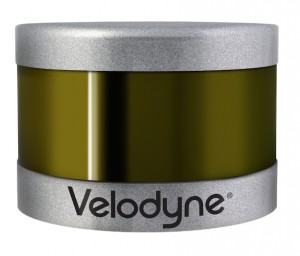
Sensor prices for autonomous driving are too high for widespread use. This lidar sensor, which fits in the palm of your hand, starts at $8,000.
Cars loaded with the technology that allows them to drive themselves have been cruising the streets of downtown Detroit this week, but unless the costs of a critical component come down dramatically, don’t expect them to be in showrooms any time soon.
Self-driving or autonomous cars currently rely on several sensors to help perform the functions of driving. However, the sensors are expensive and are not developed specifically for cars and trucks, but adapted and modified from other areas.
“The cost of sensing and processing is going to have to move down a lot if we’re going to make a manageable and a large-scale deployment of autonomous automated vehicle technology over the next few years,” said John Lauckner, General Motors’ chief technology officer, during a recent forum at the ITS World Congress in Detroit.
The sensors used by current crop of test vehicles cost more than “a few hundred buck” and they’ll need to drop below $50 before they’ll be implement across all car lines, at least at GM, Lauckner noted.
However, the price skyrockets even more when you include lidar sensors. Lidar is laser radar. Toyota’s new Single Photon Avalanche Diode (SPAD) lidar system, which is a radar-like system that uses light instead of radio waves, is used in several prototype self-driving cars, but this version is more compact. Toyota says it can be mounted inside a vehicle, negating the need for the spinning roof-mounted boxes used by Google and others. It can operate at speeds approaching 70 mph.
The cost of the average lidar sensor package exceeds $25,000, Lauckner noted. However, there is some progress being made on that front. One of the latest generation lidar systems comes from a California-based company named Velodyne. It touts that its new 16-channel real-time lidar sensor is both substantially smaller and significantly less expensive than previous generation sensors.
The cost? $7,995.
Ford, Honda and Toyota representatives on the panel agreed that sensor costs are too high and are one of two impediments slowing the development of a commercially viable autonomous vehicle.
“I’m optimistic that (the price of) sensors will come down,” said Ahmad Bahai, chief technology officer, Texas Instruments. “Hopefully we’ll see this price reduction mirror those of semi-conductor prices.”
(Cadillac to offer nearly autonomous vehicles by 2017. For more, Click Here.)
The other impediment is a lack of a sensor designed specifically for an automobile. It not only must be able to handle and process a lot of data, it’s also got to be able to handle the rigors of being on a roadway: bouncing, jostling as well as potential weather extremes.
(Click Here for details Toyota’s attempt to redefine urban utility.)
The upside is that sensor manufacturers understand the desire of automakers to seek the costs drop. More importantly, they’re seeing significant growth in sensors.
(To see details on VW’s plans to get American input into U.S. cars, Click Here.)
In 2011, the automotive industry represented about $60.4 billion in business. Next year, it will jump to $88.6 billion, according to Frost & Sullivan. That 9.9% annual growth rate is expected to continue for some time as the need for sensors increases for vehicles as well as the infrastructure supporting cars and trucks.
